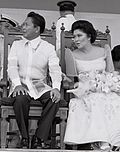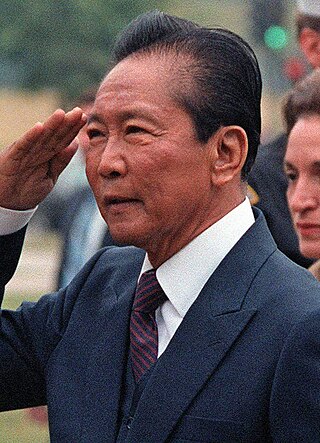
Ferdinand Emmanuel Edralin Marcos Sr. was a Filipino politician, lawyer, dictator, and kleptocrat who served as the tenth president of the Philippines from 1965 to 1986. He ruled under martial law from 1972 until 1981 and kept most of his martial law powers until he was deposed in 1986, branding his rule as "constitutional authoritarianism" under his Kilusang Bagong Lipunan. One of the most controversial leaders of the 20th century, Marcos's rule was infamous for its corruption, extravagance, and brutality.
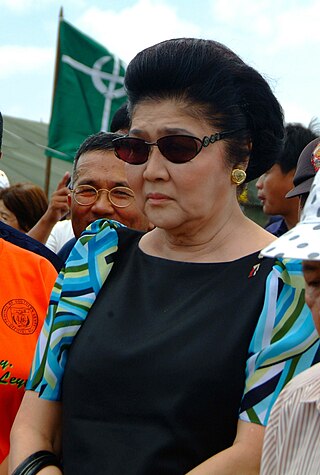
Imelda Romualdez Marcos is a Filipino politician who was First Lady of the Philippines from 1965 to 1986, wielding significant political power after her husband Ferdinand Marcos placed the country under martial law in September 1972. She is the mother of current president Bongbong Marcos.
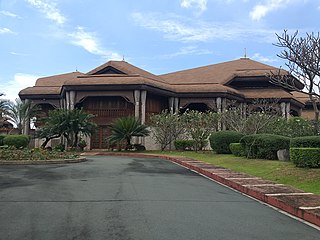
Coconut Palace, also known as Tahanang Pilipino, is a government building located in the Cultural Center of the Philippines Complex in Manila, Philippines. It was the official residence and the principal workplace of the vice president of the Philippines during the term of Jejomar Binay.

The San Juanico Bridge is part of the Pan-Philippine Highway and stretches from Samar to Leyte across the San Juanico Strait in the Philippines. Its longest length is a steel girder viaduct built on reinforced concrete piers, and its main span is of an arch-shaped truss design. Constructed during the administration of President Ferdinand Marcos through Japanese Official Development Assistance loans, it has a total length of 2.16 kilometers (1.34 mi)—the second longest bridge spanning a body of seawater in the Philippines after the Cebu-Cordova Bridge. It was also the longest bridge in the Philippines upon its opening in 1973, surpassed in 1976 by Candaba Viaduct of North Luzon Expressway (NLEX), another bridge that connects from one province to another, connecting the provinces of Pampanga and Bulacan.

The Philippine Heart Center is a hospital in Central, Quezon City, Philippines, specializing in the treatment of heart ailments. It was established in 1975.

The Cultural Center of the Philippines Foundation, Inc. is a government-owned and controlled corporation established to preserve, develop and promote arts and culture in the Philippines. The CCP was established through Executive Order No. 30 s. 1966 by President Ferdinand Marcos. Although an independent institution of the Philippine government, it receives an annual subsidy and is placed under the National Commission for Culture and the Arts for purposes of policy coordination. The CCP is headed by an 11-member Board of Trustees, currently headed by Chairperson Margarita Moran-Floirendo. Its current president is Arsenio Lizaso.

The Philippine International Convention Center is a convention center located in the Cultural Center of the Philippines Complex in Pasay, Metro Manila, Philippines. The facility has been the host of numerous local and foreign conventions, meetings, fairs, and social events.
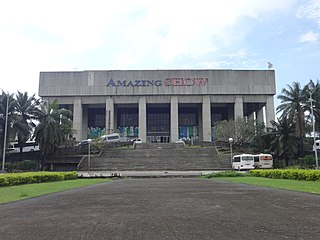
The Manila Film Center is a national building located at the southwest end of the Cultural Center of the Philippines Complex in Pasay, Philippines. The structure was designed by architect Froilan Hong where its edifice is supported on more than nine hundred piles which reaches to the bed-rock about 120 feet below.

Francisco "Bobby" Tronqued Mañosa was a Filipino architect considered one of the most influential Filipino architects of the 20th century for having pioneered the art of Philippine neovernacular architecture. His contributions to the development of Philippine architecture led to his recognition as a National Artist of the Philippines for Architecture in 2018.

The Lung Center of the Philippines (LCP) is a government tertiary hospital specializing in the cure and prevention of lung and other chest diseases, located on Central, Quezon City, Philippines. The center receives budgetary support for its operations from the national government. It was constructed on public land donated by the National Housing Authority.

Bay City, also known as the Manila Bay Freeport Zone and Manila Bay Area, is the name for the reclamation area on Manila Bay located west of Roxas Boulevard and the Manila–Cavite Expressway in Metro Manila, the Philippines. The area is split between the cities of Manila and Pasay on the north side and Parañaque on the south.

Deyan Sudjic is a British writer and broadcaster, specialising in the fields of design and architecture. He was formerly the director of the Design Museum, London.
The City of Man was a re-branding campaign aimed to improve the image of Manila, the capital of the Philippines. The name was in reference to a shortened version of the name of Manila, and the campaign was launched by the Governor of Metro Manila and then first lady of the Philippines Imelda Marcos to reshape the city with an eye to world tourism, commerce and economic power and development. Under her campaign, several urban projects were undertaken to make Manila the world's center of international tourism and finance.

The People's Park in the Sky, often simply called People's Park and originally named Palace in the Sky, is a historic urban park in Tagaytay, Cavite, Philippines.

The Sofitel Philippine Plaza Manila is a luxury hotel in Pasay, Metro Manila, Philippines under the Sofitel hotel chain of AccorHotels.

The Cultural Center of the Philippines Complex, also known as the CCP Complex, is an 88-hectare (220-acre) art district managed by the Cultural Center of the Philippines (CCP) located along Roxas Boulevard in Metro Manila, Philippines. It is a mixed-use cultural and tourism hub overlooking Manila Bay in south-central Manila, most of which fall under the jurisdiction of the city of Pasay.
Rodolfo Cuenca, sometimes known by his nickname, Rudy Cuenca, was a Filipino businessman best known as the chairman of the Construction and Development Corporation of the Philippines (CDCP), which is known today as the Philippine National Construction Corporation. He was a close associate of Ferdinand Marcos, and was noted not to be embarrassed by "his much-criticized close association with Marcos and his being tagged as a crony."

The 21-year period of Philippine economic history during Ferdinand Marcos’ regime – from his election in 1965 until he was ousted by the People Power Revolution in 1986 – was a period of significant economic lows.

The Marcos jewels generally refers to the jewelry collection of the Marcos family – most famously that of former First Lady Imelda Marcos. However, it also specifically refers to three collections of jewelry which were recovered by the Presidential Commission on Good Government (PCGG) in 1986, which the Philippine Supreme Court had ruled to be part of the Marcoses' unlawful wealth.
Ferdinand Marcos developed a cult of personality as a way of remaining President of the Philippines for 20 years, in a way that political scientists have compared to other authoritarian and totalitarian leaders such as Joseph Stalin and Adolf Hitler, but also to more contemporary dictators such as Suharto in Indonesia, Saddam Hussein in Iraq, and the Kim dynasty of North Korea.


















